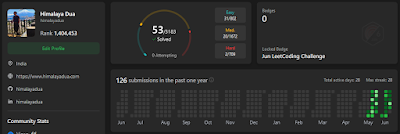Mind Mapping the Algorithmic Challenge - Blind75
"Boundaries are basically about providing structure, and structure is essential in building anything that thrives."
This blog is part of my leetcode journey blog and you can access the complete list here.
Mind Mapping the Algorithmic Challenge: The Importance of LeetCode Categories
In the realm of competitive programming and interview preparation, LeetCode stands out as a premier platform for honing one’s coding skills. A unique feature of LeetCode is the categorization of problems into distinct groups, which are commonly referred to as problem domains or categories. These categories include arrays, binary manipulation, dynamic programming (DP), graphs, intervals, linked lists, matrices, strings, trees, and heaps.
But what exactly are these categories, and how do they aid in the learning process?
Understanding the Categories
Each category represents a specific type of data structure or algorithmic technique. For instance:
- Arrays involve problems that require manipulating linear data structures where elements are identified by indices.
- Binary relates to problems involving binary operations or binary search algorithms.
- Dynamic Programming (DP) encompasses problems that can be broken down into simpler subproblems, which are then solved once and stored for future reference.
- Graphs include challenges that involve nodes and edges, requiring algorithms for traversal or shortest paths.
- Intervals deal with problems that involve ranges or periods of time.
- Linked Lists are about managing a sequence of elements where each element points to the next.
- Matrices involve two-dimensional arrays, often requiring navigation or pattern recognition.
- Strings focus on problems related to text manipulation.
- Trees are hierarchical structures, with problems often involving traversal or structure manipulation.
- Heaps are specialized tree-based data structures that prioritize the highest (or lowest) element.
The Role of Categories in Learning Algorithms
These categories serve as a mental framework for tackling the vast array of algorithmic problems. By dividing the problem space into manageable chunks, learners can focus on mastering one domain at a time. This approach has several benefits:
- Structured Learning: It provides a roadmap for beginners to start with simpler concepts and gradually progress to more complex ones.
- Pattern Recognition: Regular exposure to problems within a category helps in recognizing common patterns and devising strategies for similar problems.
- Efficient Practice: Focusing on one category at a time allows for targeted practice, which can be more effective than a scattered approach.
- Knowledge Retention: Categorization aids in better retention of concepts as related problems reinforce the underlying principles.
- Confidence Building: Mastery of individual categories builds confidence, which is crucial for performing under the pressure of interviews or competitions.
As you embark on your journey through the algorithmic landscape, let these categories be your guideposts, leading you to a deeper understanding and proficiency in the art of problem-solving.
Blind 75 - Categories
Binary
Dynamic Programming
Graph
Interval
Linked List
Matrix
String
10 articles
Tree
13 articles
Heap
2 articles


Comments
Post a Comment